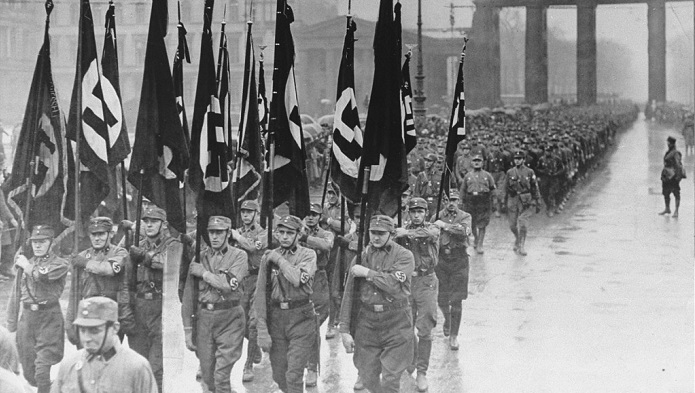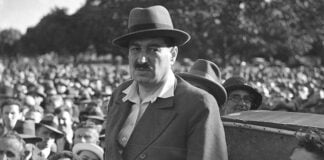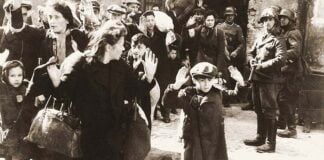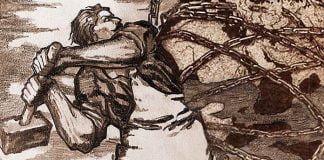Hitler came to power 90 years ago this week. Tom Orsag argues that his rise was not inevitable and that working class unity in action could have stopped the Nazis
The spectre of fascism is haunting Europe today in country after country—Italy, France, Sweden and Hungary. So it’s important to talk about how 90 years ago, on 30 January 1933, the Nazis came to power in Germany.
Some of the mistaken arguments on the left that led to tragedy then are still around today. In France today, for example, some say that only revolutionaries can really fight fascism—so there is no attempt to broaden involvement to involve reformists—or that solving unemployment and poverty is enough to beat back the fascists, with no specific anti-fascist campaign being needed.
In Germany in 1933, the Nazis did not have a majority in parliament and neither did they seize power. Instead, it was handed to them by the German ruling class after Hitler won just 37 per cent of the vote.
The German president, former general Paul von Hindenburg, appointed Hitler chancellor (prime minister) in a coalition government, after initially being wary of Hitler and the Nazis, who were seen as a gamble.
How would the best working class movement of Europe, with two large left-wing parties and powerful trade unions, respond? The answer is that they were smashed in a matter of months, leading Germany on to the path of imperial war and the Holocaust. It was a tragic and avoidable defeat for the left.
Learning the lessons from that time, and drawing on the united front method outlined by Russian revolutionary Leon Trotsky, we can have hope that it is possible to stop fascism today.
The Nazis
So who were the Nazis? They emerged from among the Freikorps, gangs of former soldiers and middle-class riff-raff that formed after Germany’s revolution of November 1918, which brought down the kaiser (emperor) and installed a Social Democratic Party (SPD) government.
The SPD had a mass working class base up until 1933 but in 1918 it saw its task as recreating the German state machine in the new Weimar Republic, using reliable sections of the military and the Freikorps against armed workers, sailors and soldiers, who staged ad hoc, localised revolts. During this period, the Freikorps became the first to use the swastika emblem.
Germany was a federal government. The Nazis were just one of many far-right groups that emerged on the fringes of national political life but they gained protection in one state, Bavaria.
Apart from being anti-communist, what kept the diverse middle-class elements of the Nazis together ideologically was antisemitism, even though Jews were less than 1 per cent of the population. The Nazis did not always campaign in elections on antisemitic slogans but the hatred was used to bind its core membership together.
A member who joined early on was Adolf Hitler, a former German wartime corporal, originally from Austria. He had learnt antisemitism from the mayor of Vienna, Karl Lueger, and a rich Austrian MP, Georg Ritter von Schonerer. This MP was called Fuhrer (Leader) by his supporters and they greeted each other with Heil (Hail).
Hitler also admired the American antisemite Henry Ford, the founder of Ford car company, who spent millions of dollars publishing antisemitic articles and pamphlets for popular consumption.
A right-wing street attack in July 1922 on a republican journalist and an editor saw Hitler say: “Nothing lasting can be achieved by a handful of conspirators using dagger, poison and pistol. What is needed is a hundred thousand and again a hundred thousand, fanatical fighters for our view of life. The work must be done, not in secret but in overwhelming mass demonstrations and the conquest of the streets.”
This points to one prong of his strategy and also his weakness. As Hitler confessed months after he took power: “Only one thing could have broken our movement—if the adversary had understood its principle and from the first day had smashed, with the most extreme brutality, the nucleus of our new movement.”
Hitler tried to launch a coup in Munich, Bavaria, in November 1923 as a stepping stone to marching on Berlin. The German word for coup is putsch. It started in a beer hall and was dispersed by Bavarian police firing into Hitler’s mob on the streets.
Hitler was jailed, with a light, short and comfortable prison sentence. His new second prong was to use propaganda and elections to win partial, popular consent for his plans for dictatorship. To use his words: “Democracy must be defeated with the weapons of democracy.”
Initially, that did not work. In the May 1928 national elections, the Nazis won just 2.6 per cent—810,100 votes. But the Nazis were persistent in their plans to destroy the working class movement and had from the beginning of the 1920s a small minority of the capitalist class willing to finance them.
They included Alfred Hugenburg, the right-wing newspaper magnate, Fritz Thyssen, steel and coal mining, Emil Kirdorf, who was not antisemitic, from the industrial Ruhr, and Sir Henri Deterding from Shell Petroleum.
The economic crisis that followed the Wall Street stock market crash of October 1929 changed the Nazis’ fortunes. Industrial production collapsed and there was mass unemployment and poverty, affecting many members of the middle class as well as workers.
During 1929, the party’s membership rose to 175,000 and by the end of 1931 it stood at 800,000, with 225,000 storm troopers.
In the September 1930 election, caused by the resignation of a coalition government led by the SPD, the Nazis won 6.4 million votes (18.3 per cent), mainly from the centre parties, whose middle-class voters were deserting them due to bankruptcy.
In January 1932, Hitler was invited “to address the captains of the Ruhr industry”, Germany’s coal, iron and steel heartland in the west. They were reassured by Hitler that he would not damage their interests.
In the July 1932 national elections, the Nazis vote rose to about 13.7 million or 37.3 per cent. During the election campaign, Hitler said: “I have set myself one goal: to sweep all 30 parties out of Germany.”
With no coalition government being able to be formed, another national election was called in November 1932, which saw the Nazi vote fall to 11.7 million or 33.1 per cent.
In July, the combined vote for the two working class parties—the SPD and the Communist Party (KPD)—was 13.2 million or 35.9 per cent. In November it rose to 37.3 per cent.
But who ruled Germany was not going to be decided on just votes. The Nazis’ ability to confront the left in the streets was the key.
Although they presented themselves as saviours of their base in the middle class that was under pressure from the economic crisis, the Nazis were really setting out to destroy working class organisations for capitalism.
The ruling class
The German ruling class felt under threat from the 1918 revolution and the SPD, which described itself as Marxist.
Barely 18 months after the revolution, a section of the officer corps launched a putsch in March 1920 to overthrow the SPD and form an autocratic government.
The Kapp-Luttwitz putsch, fronted by an ultra-nationalist minor state minister and a general, was a military success in Berlin. But it was defeated by a mass national general strike called by a right-wing trade union official, while the SPD government ministers ran away. The putsch collapsed within days.
The determined response by the whole working class to defend the republic pulled many traditionally conservative white-collar workers along with it. The KPD congress later that month was told: “The middle ranking railway, post, prison and judicial employees are not communist and will not quickly become so. But for the first time they fought on the side of the working class.”
The ruling class was stung and haunted by this determined display of working-class power, which was a prelude to a potential revolution in 1923.
For a period, American loans helped stabilise the economy and curb hyperinflation. But with the onset of the Great Depression in 1929, the ruling class could see that the SPD was out of answers and prepared to move against it. The Nazis with their storm troopers gave them leverage against the left.
General Kurt von Schleicher was President Hindenburg’s key advisor. He said: “In the form of the Nazis there exists a counter-weight” to the working class. He added: “If they did not exist, one really would have to invent them.”
For the Nazis to rule German capitalism, they had to be invited into the bourgeois parlour by the capitalists … and they were.
Hitler was given power at the very moment his influence began to wane. After the November 1932 result, his Propaganda Minister Joseph Goebbels wrote in his diary that the Nazis’ failure to take power in July was causing demoralisation in the ranks and thousands were leaving.
German capitalism saved the Nazis from disintegration so that they in turn could save the bosses from the left.
Social Democratic Party
The SPD was like the Labor Party but with much more left-wing rhetoric. It supported the German ruling class during the war and paid the price of splitting into three parts.
The right-wing section led by the likes of Frederich Ebert, Gustav Noske and Phillip Schiedemann tried to hold back the 1918 revolution.
Ebert said: “I hate the social revolution like sin.” Noske said: “Someone must be the bloodhound” in his quest to assassinate the leaders of the KPD—Rosa Luxemburg and Karl Liebknecht—and revolutionary workers not willing to stay within the confines of the capitalist system.
The centre of the SPD, which was half against the war, split in 1916. The left, which was totally against the war and for revolution, became the KPD in 1918.
In 1930, an SPD-led coalition government that included capitalist parties fell apart as it tried to make the German working class pay for the Depression. Out of office, the SPD continued to vote for cost-cutting measures. This left the field open for the Nazis to say they had solutions to the crisis.
The SPD responded to the Nazis’ rise by relying on constitutional politics. As one SPD minister put it, the SPD had forced the Nazis onto the terrain of “legality”, which would defeat them. Trotsky’s response was sharp, that the ruling class needed Hitler and “necessity knows no law.”
The SPD said that the Prussian state government which they ran, with its 50,000 armed police (many of them party members), was a defence against the Nazis. But in July 1932, President Hindenburg and the chancellor, Franz von Papen, issued a constitutionally legal decree to dissolve the SPD government of Prussia. The SPD meekly obeyed and gave up the state without a fight.
The SPD had built a mass armed self-defence group. Yet they insisted it was for defensive purposes only for use if the Nazis ever broke the constitution—a moment that never came.
Mass protests took place in Berlin and other Prussian cities against the dissolution of the state government. The “responsible” leaders of the SPD decided they would do nothing. This was the dress rehearsal for the elevation to power of the Nazis six months later.
The Communist Party
The KPD was formed during the revolution of 1918 and under the impact of the Russian revolution. Its ablest leaders, Rosa Luxemburg and Karl Liebknecht, were murdered by the military in January 1919, under orders from the SPD government. Another leader, Leo Jogiches, was killed soon after for looking into their assassinations.
The KPD should have been the most dynamic party to respond to the Nazis because it was the party of revolution and had a mass base—300,000 members on the eve of the catastrophe. And Nazism, after 1929, was the most dangerous weapon against the revolution. The onus was on the KPD and it was found wanting.
As Joseph Stalin consolidated his counter-revolution inside Russia, he demanded that all communist parties become monolithic parties of no debate. He wanted pliant national leaders and chose Ernst Thaelmann as KPD leader in late 1925.
In 1928, Stalin declared that fascism and the SPD were “twins” and that the SPD was the principal enemy of the working class because it was “social fascism”—socialist in word, fascist in deed. This was the worst sort of fatalism. According to this twisted logic, fascism already existed in the form of the SPD in government.
Applied to the German crisis loyally by Thaelmann, this policy was a disaster. From 1929, the KPD’s main political thrust was to criticise the SPD as “social fascist” and the biggest threat. Communists fought the Nazis in the streets but they did so alone, making it look like a street fight between two gangs, rather than a matter of life and death for the whole working class.
The KPD’s sectarianism cut them off from reformist workers inside the SPD at a time when the SPD’s leaders’ words and actions could have made it easier for the KPD to have joint defensive actions against the Nazis. The SPD rank and file saw the danger of the Nazis, more so than their leaders.
The problem for the KPD in 1930 was that the SPD, despite losing electoral support, was still a powerful organisation. In September, 89.9 percent of elected factory committee members were SPD supporters. The KPD had less than 5 per cent of the leadership on factory committees.
Instead of calling for united working class action to stop Hitler, the KPD became ever more sectarian. In August 1931, the Nazis backed a right-wing referendum to dissolve the SPD-run Prussian state government—totally legal under the Weimar constitution. The KPD backed the Nazi Yes vote, calling for a “Red Referendum”. The referendum failed but the damage was done.
Finally, as Hitler was appointed Chancellor on 30 January 1933, Thaelmann called for a united general strike against Hitler. But after four years of calling the SPD “social fascists’, and because of the KPD’s lack of the roots in the factories, workers did not respond.
Stopping fascism today
Academic Hitler experts, like Ian Kershaw and others, maintain Hitler could not have been beaten. This is fatalism of the worst order. Leon Trotsky, exiled in Turkey by Stalin, argued that the KPD should initiate a united front with the SPD to stop the Nazis, while remaining politically independent.
The KPD had called for a “United Front from Below”, without SPD leaders involved. But as Trotsky argued, this amounted to demanding that SPD workers simply follow the KPD. An effective united front needed the involvement of at least some SPD leaders so that their members would feel confident to move into action.
Even as late as 1932, unity of the left—the SPD, KPD and the unions, based on a fighting defensive program—could have made the price of backing the Nazis too high for the ruling class to pay.
With the SPD relying on the state machine to thwart Hitler on the one hand and the KPD refusing unity in action in the name of fighting “social fascism”, the left was divided, allowing the Nazis to come to power.
Working class unity against fascism, based on action and the freedom to debate, is needed today. Building a revolutionary left that knows how to draw reformists into action against the Nazis is a vital part of that equation.
By Tom Orsag






